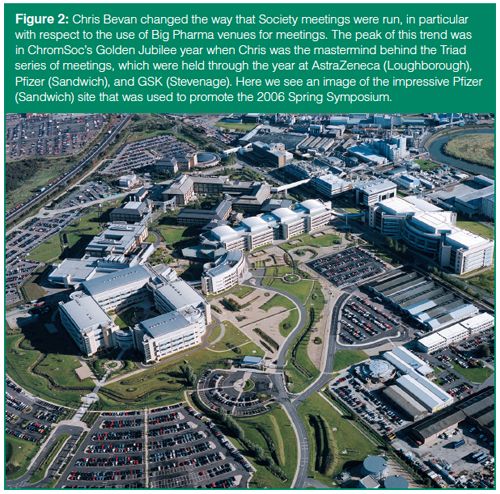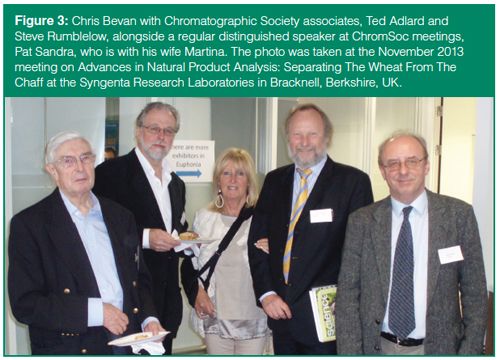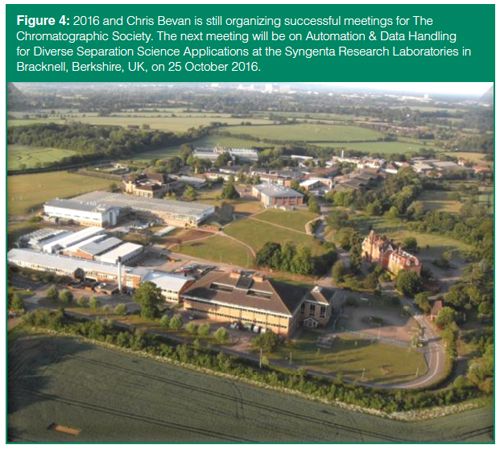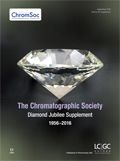The Changing Face of The Chromatographic Society and Chromatography in a Changing World
Special Issues
Chris Bevan, the longest serving President of The Chromatographic Society in recent times, is interviewed by another former President of The Chromatographic Society, John Lough, on the evolution of The Chromatographic Society and chromatography in a changing world.
Chris Bevan, the longest serving President of The Chromatographic Society in recent times, is interviewed by another former President of The Chromatographic Society, John Lough, on the evolution of The Chromatographic Society and chromatography in a changing world.
John Lough: Going back to when you first became President in 2000, it was actually quite an unusual event. For only the second time in two instances from 1990 to 2016 it came down to a vote. In keeping with the theme of this interview, the issues were around the external context. In challenging circumstances, it was down to whether The Chromatographic Society could continue to thrive as an independent group or whether it was necessary to cooperate extensively or actually merge with other bodies operating in the same or overlapping areas. Looking back now, do you still believe that retaining the Society and its name was the correct thing to do to meet the challenging circumstances at that time and has that decision served us well since that time?
Chris Bevan: I most certainly do believe it was right to retain the Chromatographic Society’s wellâestablished name and to continue to promote its mission as an independent scientific charity representing the interests of separation scientists. The problem was our outdated financial model, not our good reputation, and performance in delivering symposia and discussion meetings on chromatography and allied techniques. To dilute our impact by merging us with other groups would have weakened us and I suspect we would have disappeared.
JL: You went on to transform the Society’s finances (a) by reorganizing our management with the concomitant closure of our office, and (b) moving more towards symposia held in major pharmaceutical company venues with the commensurate increase in rates for exhibiting involved. Was this some kind of grand master plan or were you just having to respond very quickly to changing circumstances? More importantly, what was the exact nature of these circumstances?
CB: Surprisingly the challenge was not just from the difficult prevailing external financial circumstances. I have mentioned our “outdated financial model”. We were, if you like, the author of our own potential downfall by our insistence in doing what was right for chromatography. The Society was one of the three founder members of the International Symposium on Chromatography (ISC) series of symposia along with the French and German separation societies. The financial surpluses from these symposia provided the Society with most of its funds. Unfortunately, the surpluses, although high, were too infrequent to deliver a regular and sufficient income stream to meet our expenditure. Furthermore, we felt that more countries should be allowed and encouraged to host these meetings and therefore the ChromSoc’s proportion of the surplus would be less in the future. The Society has always had support from its volunteer committee members and from various companies who allowed us to use their premises for meetings for free or low rentals. We ran an office for many years with two secretaries and for these we were paying full commercial rates.
I reviewed the charges we were asking from companies to exhibit their products at our meetings and realized that they were insufficient to meet our expenditure. Closing offices to save money is the emotionally easy bit, but making old friends and loyal colleagues’ jobs redundant is another matter altogether. The way I saw it was that if we didn’t act quickly then we wouldn’t have enough money to pay a fair redundancy payment to our loyal staff so the decision was inevitable if the society was to continue.

JL: You have held an important position in a major multinational pharmaceutical company. The Society had strong links with UK pharmaceutical companies and so it was fitting that the Society celebrated its Golden Anniversary in 2006 with your Triad series of Big Pharma meetings. Times have changed. The Triad could not be repeated today. You are ideally placed to comment: Have you any observations to make on the changes in the pharmaceutical industry in the last 10 years? Have these changes had an effect on “what chromatographers do”?
CB: I have witnessed the global expansion and subsequent contraction of the pharmaceutical industry over the past 40 years - both from an international and a UK perspective - having been employed by Hoechst, Glaxo, GlaxoWellcome, and GSK. The scientific innovations and their realizations coupled with the wide application of ingenious technologies have impressed me. The changing markets and the lack of drug-sensitive targets and diseases for which there are no animal models have challenged the industry.
Chromatographers used to be an elite group within analytical and process science departments, but nowadays they are dispersed and have become nonspecialists. Much of the analysis that used to be performed manually is now fully automated and run in a preprogrammed manner. The oddball situation is often ignored if the result doesn’t quite fit into the automated systems agenda. Chromatographic scientists now must have a broader appreciation and understanding of mass spectrometry (MS), nuclear magnetic resonance (NMR), and the world of the largeâmolecular-weight biomolecules, rather than the small drug molecules. The advances in computational molecular modelling have also had an impact in separation sciences and in physicochemical property prediction and measurement.
It is quite unusual to find an isolated specialist chromatographer in big pharma anymore and multidisciplinary analytical teams have been disbanded because of economies and a reluctance to risk future venture capital on longer-term goals. Late failures to deliver new profitable drugs in a reasonable time is making even large companies somewhat riskâaverse. It is important that the young multidisciplinary chromatographers of today still strive to maintain the excellent team spirit and inventive cooperation that has always been the hallmark of the UK’s pharma R&D scientific fraternity.
JL: Again, looking outside of the Society, there are other societies working on the development of chromatography. I am thinking here mainly about Europe. You were noted in the early 2010s for your sterling efforts in trying to modernize the European Society for Separation Science (EuSSS). However, you eventually came to the conclusion that EuSSS was ineffective at coordinating and delivering separation science activities in Europe, with all the disparate groupings failing to come together. Looking back, notwithstanding the point that ChromSoc committee members do not have infinite time available to them, do you think that was a moment when ChromSoc could have grasped the nettle and widened its horizons to become a Europe-wide Chromatographic Society?
CB: As the Society’s Honorary Secretary and later as its President I was very much in favour of maintaining the Society’s connections with societies abroad and met many scientists who were equally passionate to cooperate internationally. A great deal of sterling work was undertaken by the Germans, French, Austrians, Belgians, Italians, Spanish, Scandinavians, Polish, and the Hungarians to establish the legal framework and financial foundations of EuSSS. I went to a number of excellent conferences and committee meetings that were run by these pioneering EuSSS scientists. However, it became apparent that most of the European separation science and chemical societies had their primary focus on running symposia in their own countries. The emergence of Eastern European countries also affected the financial model for running a Europe-wide society, encountering many similar issues to those facing the Eurozone countries today. Our UK-based Chromsoc symposia were running well and attracted many Europeans, while the number of UK delegates attending European conferences was dwindling. The Society’s horizons must be determined by and reflect the interests of its members and attendees and these seem to be UK-centric at present. European members and non-members have always been welcome to come to our national and international meetings and have done so in considerable numbers over the years.

JL: Your current role involves being one of the principal meeting organizers. Elsewhere in this supplement, there are several other individuals looking ahead to the future of chromatography. So, the question here is simple - what are the areas of chromatography that are currently exciting you and which will feature in your forthcoming meetings?
CB: I see the further development and application of supercritical fluids to chromatography coming back into vogue to enable purification
and isolation of biochemicals and natural products. I am told that it is more selective, eco-friendly, and energy efficient than using conventional solvents. On the analytical scale I see progress in the further miniaturization and automation of separations science, particularly for the separation of complex biological molecules and those related to the understanding of the human genome and its complex mechanisms. The biggest current challenge for analytical chemistry is from the complex biochemical and biologicalârelated fields, and the coupling of chromatographic and electrophoretic techniques with structural elucidation techniques are essential prerequisites for success.
JL: You have seen and heard a lot, so, to go back to the meetings you have staged in the past 60 (sorry, 25–30!) years and chromatographers you have met at Chromatographic Society and international meetings, are there any memories you’d like to share with us? Who were your favourite speakers? Who impressed you most as a chromatographer?
CB: Following a PhD in neutron activation analysis and chemical oceanography, I started applying and developing liquid chromatography (LC) methods for blood drug analysis with Hoechst Pharmaceutical Research laboratories back in 1976 using early Waters high performance LC (HPLC) equipment. I was curious to meet and get to know Jim Waters and at the ChromSoc 50th anniversary “Triad” meeting in 2006 at GSK, I had the honour of presenting him with the Martin Medal. Talking of Archer Martin, I heard his last lecture because he was our invitee plenary speaker at the London ISC symposium. Tragically, the next time I saw Archer Martin was on a BBC TV programme on Alzheimer’s with his daughter. His Nobel Laureateâwinning brain had been made dysfunctional by plaques; surely a challenge for future chromatographers to make sure they make an important contribution to the underpinning technological advances needed to elucidate the mechanisms of this evil and disabling disease.
Discussions in the bar and at dinners and social events at symposia are the places where one has an opportunity to get to know other scientists personally and gain insights into their work. I was particularly delighted to see that my freeze-thaw switching invention had found an important application in the analysis of the human genome as a result of a casual conversation at York University HPCE course with Ed Yeung. Ed had mentioned that he had problems switching flows and derivatizing analyte peaks in his multiple (96) capillary electrophoretic systems and needed a reliable, very low volume valve. I had been developing a suitable method for achieving this and he decided to apply it in his laboratory. This sort of instance is what makes innovative science so rewarding.
Nearly 50 years in analytical chemistry and associated sciences have left me with a perspective that I believe is unique. The scales of chromatography I have worked on have been from the ultraminiaturized 50-µm CE capillaries to the 6-inch diameter large-scale prep columns, all performing separations: a scaling factor range of over 3 log orders. Determining nanogram per millilitre concentrations in trace analysis to tens of grams separated out preparatively - all-in-a-day’s (or a career’s) work for the practising separations scientist.
I have thoroughly enjoyed my career in science and met many excellent scientists in many different countries. I admire and enjoy the company of those people who are willing to share their thoughts and make real attempts at explaining their discoveries to others who may not be from their discipline or understand the specialized terms of their language. Interdisciplinary discussions are fundamental to the solving of most of today’s problems and a convivial atmosphere is vital to catalyze these discourses. I hope that the society will continue to foster such opportunities for all scientists to ensure that chromatography and electrophoresis are recognized by the public as backroom tools in the analysts’ armoury, so essential to many companies.
Should any one reading this have an aspiration to become a Society committee member don’t hesitate - it will enrich your social and scientific life and you will meet a great bunch of people and their families.

JL: Thanks, Chris. That’s a very uplifting thought with which to finish. Thank you very much for your time and, by way of thanks, we will give you a final bonus question! Several others have been given the opportunity through other articles in this publication to give their views on what have been the important developments in chromatography over the past 60 years and we hear from you again. However, for you, what has been THE major step forward?
CB: Today this may seem really obvious to our readers, but back in the 1960s when I was doing my BSc degree in analytical chemistry it would not have been predicted by the average analyst. In the late 1960s most analytical chemistry was performed manually and without sophisticated instrumentation. Burettes and pipettes for wet volumetric analysis and balances for gravimetric analysis coupled with quantitative measurements obtained from manually transcribed readings from spectrometers were commonplace. Statistical measurements derived from many thousands of determinations were unusual and quite tedious to perform, even with the help of a mechanical calculation machine (the FACITs and Brunsvigas were my mechanical GameBoy toys at that time).
The ubiquitous peak area measurement for quantitative calibrations was done by printing out on a chart recorder and cutting out the peaks and weighing them - I kid you not!
I was very fortunate to start my analytical career immersed in the world of nuclear physics. Nuclear physicists had access to the best tools for rapid calculations and I used them widely for my PhD. Gamma ray photo peak areas and background subtraction were calculated and processed on a large mainframe computer at Harwell’s Rutherford labs ATLAS computing centre and at the University of London’s IBM370, employing a program called SAMPO written by Routti (1). Data was recorded onto punched paper tape and punched cards from the 4096 multichannel analyzer gamma ray spectrometer. The instrument produced massive amounts of data very quickly and had I not had the computers and programs I would still be there now with my slide rule and calculator. I could have shaved at least six months from my PhD if I had had access to a modern PC.

Nowadays, no one considers it unusual to deconvolute overlapping peaks, baseline subtract, or derive linear and non-linear least squares regressions for calibration: they use many sophisticated statistical functions to measure the quality of their data.
So, the most historical development must be computational power and such easy access to it, with chromatographs becoming perhaps more intelligent than their operators before too long!
Reference
- J.T. Routti, SAMPO, A Fortran IV Program for Computer Analysis of Gamma Spectra from Ge(Li) Detectors and for other Spectra with Peaks (UCRL-19452, UC-34 PHYSICS. T10-4500, Lawrence Radiation Laboratory, University of California, Berkeley, USA, 1969).
Chris Bevan is a former Group Leader of the physicochemical characterization team at GSK and former President of The Chromatographic Society. He is now retired and works as Chromsoc’s Events Coordinator.
John Lough is a Reader in Pharmaceutical Analysis in the Sunderland Pharmacy School at the University of Sunderland, in Sunderland, UK, and a member of the Executive Committee of The Chromatographic Society.

University of Rouen-Normandy Scientists Explore Eco-Friendly Sampling Approach for GC-HRMS
April 17th 2025Root exudates—substances secreted by living plant roots—are challenging to sample, as they are typically extracted using artificial devices and can vary widely in both quantity and composition across plant species.
Thermodynamic Insights into Organic Solvent Extraction for Chemical Analysis of Medical Devices
April 16th 2025A new study, published by a researcher from Chemical Characterization Solutions in Minnesota, explored a new approach for sample preparation for the chemical characterization of medical devices.














